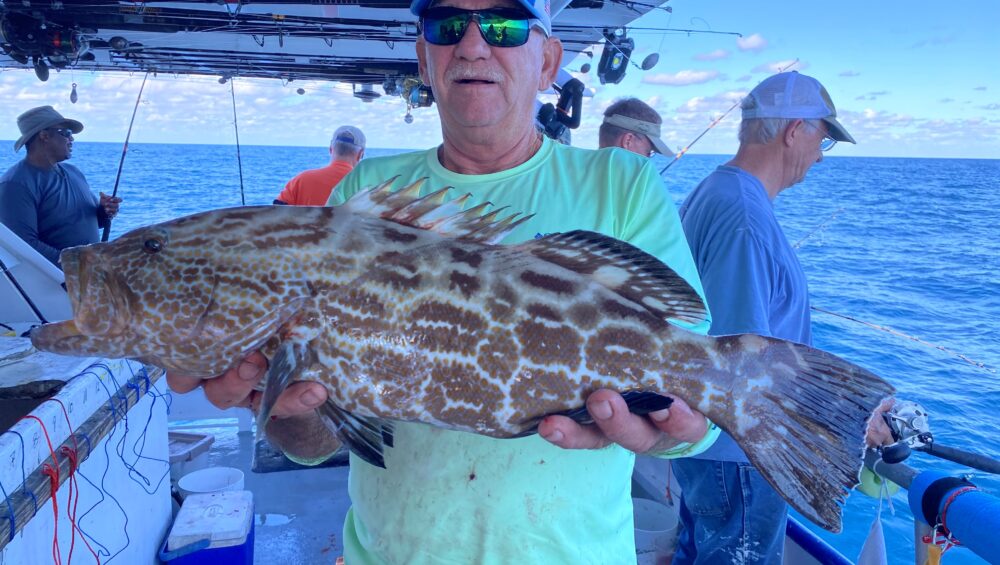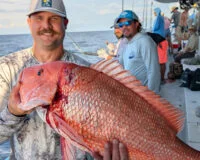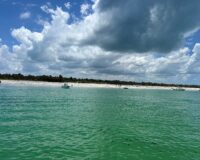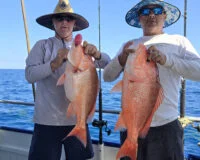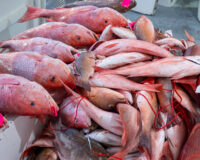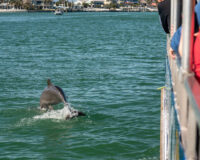Inshore Report
Sheep’s head are starting to get more and more prolific around the area as water temperatures get lower and lower. We’re seeing the sheep’s head around the dock piers, bridges, jetties, and virtually any structure that has growth that will attract them. Small pieces of shrimp with light tackle on minimal weight are the best way to target sheepshead. However, more advanced anglers will utilize fiddler crabs, small pieces of cut oyster clam, and other assorted baits. Sheep’s head love crustaceans for bait.
We’re also still seeing some snook around the passes surprisingly; but this cold snap and extreme weather might force the last remaining snook out of the passes back to the upper bays. The back bays and upper bay areas are definitely the best spot to find plentiful snook. The snook tend to be active when that weather gets a little bit more adverse. They tend to feed well during these times, in fact we’ve been seeing a lot of snook biting well this past week.
Red fish action is spread out around the flats, oyster bars, and mangrove islands. This time of year these cold fronts stir up the mullet and cause them to flush out of the back bay waters. Often behind the schools of mullet, you can find nice big redfish. The school mullet will often be scavenging over areas of grass flats, mangroves, and oyster bars and they scare up prey like shrimp, crabs, and small bait fish that the red fish love to chew on.
Trout action has been good as trout move shallower with cooling water. Trout tend to hang on edges or in potholes and around the cuts in the grass plot. We typically see trout move shallower as water cools and they typically get more concentrated and aggressive. Slow-moving soft plastics are a great option; especially imitation shrimp. DOA shrimp ARE my favorite lures to target trout this time of year.
Black drum are still moving through the passes and around the grass flats, mangrove shorelines, and dock structures. Black drum are most commonly found around local bridges. They are bottom feeders and they are cruising right on or just above the bottom looking for crustaceans such as large live shrimp or crabs. They will even bite dead bait like large Dead shrimp or even cut dead crabs.
Pompano action is typically good this time of year the only trick is trying to find these fish. They like clean clear water and lately, that’s been difficult to find. With the Hurricanes, cold fronts, and high pressure systems; it becomes tricky and challenging to find clean clear water consistently. Also, once you do find the Pompano they tend to move around which makes it hard to dial in on them day after day but you can occasionally get lucky in finding them in areas and have great success targeting them.
Flounder are also biting well. But keep in mind they are not open until December 1st. We typically find flounder on the down tide side of structure or grass flats. Any area that will hold bait; the flounder will wait just down tide on the sandy bottom waiting to ambush the bait as it passes. Flounder are great eating fish but they can be a little challenging to filet.
Surprisingly sharks are still prolific around our near shore waters. We have a few local anglers still catching them on the beach and around the passes. Some anglers are even catching them in areas of the Bay. Big bowls sambars lemons and even the occasional large black tip or spinner have been found recently. Big baits and big patience with big tackle is a good way to target and catch some pretty large sharks even right now in the cooler time of year. Typically, we have more sharks during warmer months but the average size isn’t as large as in the cooler months when we have less sharks around, but then tend to be larger.
Nearshore Report
Hogfish action has been going well around the area. Hogfish really pick up this time of year and get concentrated on small structure. Hogfish love light tackle, minimal weight and live shrimp. WE recommend 30 pound fluorocarbon leader and about a three to four OT hook with a one to two ounce weight. We catch hogfish around 30 to about 70 foot of water. Most commonly they’re caught on our five hour half day and 10 hour all day trip. We also get them on near shore private fishing charters.
Lane snapper action is still going well but unfortunately, they are closed to harvest. They will reopen January 1st. Lane snapper are fun to catch still; but they do have to go home so release them quickly and carefully so they get larger and live to see another day when you’re able to keep them.
Gag grouper have moved into the near shore waters heavily. We catch them most often on our near shore private fishing charters. The smaller boats with less lines in the water are able to target smaller spots more strategically and typically have greater success on the gag grouper. We have also seen that gag grouper, especially in shallower water tend to be a little bit more leader shy and skittish; so a smaller boat is a lot better to target those near shore skittish gag grouper. We are also catching them often on our near shore private fishing charters while trolling. The mirror lure 25 lipped diving plug has been a great asset as we target gag grouper while trolling.
Mangrove snapper action is still going on in the near shore waters. We’re catching the occasional mangrove snapper anywhere from about 50 to 100 foot of water typically using live shrimp or small pieces of cut threadfin. Mangrove snapper are typically more common in the warmer months. This time of year we catch larger mangrove snapper even near shore but not as great of numbers.
Mackerel are still around near shore. We’re catching mackerel from the beach all the way out to about 60 feet of water. Mackerel are mostly caught while trolling on our way out to go bottom fishing. We do sometimes catch kingfish and there’s still sporadic king mackerel around but the number of mackerel well outnumbers the number of king mackerel. We never really saw a big fall run of king mackerel this year.
Red grouper fishery remains closed, but they are hard to avoid when fishing near shore. We are still seeing lots of super aggressive small to medium red grouper. While it’s a great sign for the future of our fishery, it does create bit of an issue. You really need to be aware and make sure you get these guys up quickly, dehooked quickly, and back in the water quickly either with a venting tool or descending device if needed. If they are floating away dead then they will never get big enough for anyone to keep so make sure you are prepared with a good quality dehooking tool, like our hook extractor here: shorturl.at/dqY57
Offshore Report
Weather has been tricky to get offshore as of late, but we have found a few weather windows to make it out deep. Lately, the big gag grouper have been the target species and we’ve been doing pretty well targeting gag grouper out past 120 to about 180 foot of water. We are catching some nice scamp grouper mixed in with the gag grouper as well which is always a welcome addition to trips. The gag grouper have been really keyed in to the live bait recently. The bigger the live bait and the more frisky; a better gag grouper reaction bite. Big tackle with some big drag power, patience, and willingness to crank like crazy is needed to land big gag grouper successfully. We often break off more gag grouper than we catch on most trips. Getting a gag grouper off the bottom takes dedication and close attention, while actively fishing with your hand on the handle ready to go to battle at a moment’s notice. When you get that gag grouper bite; the faster you crank and put turns on the handle the more line you can retrieve with a greater increased chance of being able to land a gag grouper successfully and not letting him break you off in the bottom. Any hesitation allows that gag grouper enough stretch in the line to bring your leader, or swim down to the rocks and get cut off.
Mangrove snapper have also been biting well offshore on our 39 hour, 44 hour and 12 hour extreme trips. The average size of the mangrove snapper we are catching are quite large. The double snell rig with cut thread fins is the best target method for mangrove snapper to catch quantity. If you are looking for the best sized mangrove snapper, small to medium pin fish are a great option. While we typically catch mangrove snapper mostly at night, we also get a good daytime bite of mangrove snapper when it’s overcast.
Yellowtail snapper have actually been biting really well recently, which is kind of odd but welcomed. We are seeing a lot of yellowtail snapper once out deep past 120 feet of water and some pretty good sized ones at that. We typically catch them on cut threadfin or small pieces of squid. Along with the yellow tail we’ve been seeing big Vermilion snapper this time of year. Also plentiful porgies and almaco jacks.
Pelagic action offshore has been most notably blackfin tuna. We’ve had quite a few trips that have caught quite a good number of blackfin tuna recently. We catch them while trolling lipped diving plugs like the rapala X rap or the nomad DTX minnows. However lately we’ve also been catching plenty while flatline fishing or even dropping deadbeat or retrieving deadbeat from the bottom. There has been some kingfish out there caught but mostly blackfin tuna.

